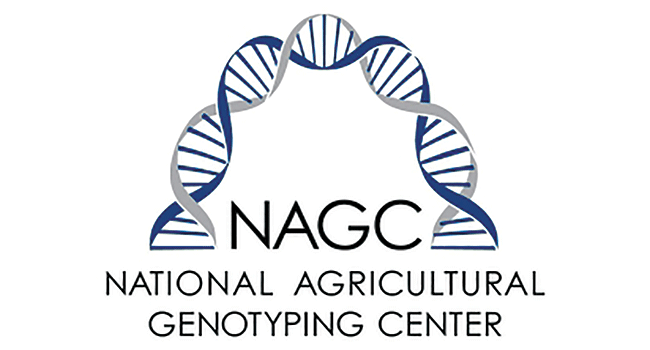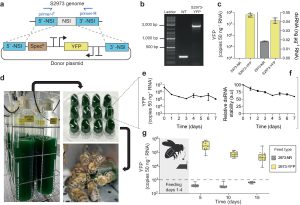By: Peter Snyder
We are pleased to report that beekeepers in the United States have a new ally in the battle to identify a variety of honey bee diseases that damage hive health.
The National Agricultural Genotyping Center (NAGC), a not-for-profit testing facility located in Fargo, ND, has developed a test panel that covers nine viral and two bacterial diseases; this includes all currently known major honey bee diseases found in North America.
We validated the full disease panel through test samples from the entire state of North Dakota and Eastern Missouri. NAGC honey bee research and assay development was undertaken with the financial assistance of the National Corn Growers Association and of the North Dakota Department of Agriculture.
The full disease panel includes testing for:
- Acute Bee Paralysis Virus
- Black Queen Cell Virus
- Chronic Bee Paralysis Virus
- Deformed Wing Virus
- Israeli Acute Bee Paralysis Virus
- Kashmir Bee Virus
- Lake Sinai Virus 1
- Lake Sinai Virus 2
- Slow Bee Paralysis Virus
- American Foulbrood Bacteria
- European Foulbrood Bacteria
The NAGC tests are highly specific because the assays are designed to identify the target diseases at the molecular level. Each of the 11 diseases has a specific genetic code that our highly sophisticated instruments can detect.
Testing Outcomes
To date, we have tested over 750 samples for the full panel of 11 diseases. We maintain the confidentiality of individual test outcomes and send a report via email only to the beekeeper who submits the sample.
However, some aggregate data is available. As an example, the North Dakota Department of Agriculture reported summary data for the 276 honeybee samples that it collected and sent to the NAGC in 2016. Of the 276 samples, 26% had no diseases detected, European Foulbrood bacteria was found in 32% of the samples, Deformed Wing Virus was found in 27% of the samples, Lake Sinai Virus 1 in 27%, Black Queen Cell Virus in 17%, Lake Sinai Virus 2 in 7%, and Chronic Bee Paralysis in 3%. The percentages total over 100% because several hives had multiple diseases.
We are seeing similar multi-disease results from several of the hives tested from Eastern Missouri and Northeast U.S., although we have also observed slight regional shifts in the disease complex present. Fortunately, none of our tests have found American Foulbrood. To establish a baseline record of disease for the honey bees, and supported by data revealing 40% of tested hives in 2016 had multiple infections, it is recommended that beekeepers seek the full panel screen.
Sample Protocol
For accurate test results, NAGC requires whole body honey bees only, using the following protocol:
- Dry honey bees (no alcohol) should be placed in breathable containers such as double-bagged paper bags. Have bags already double bagged prior to sample collection.
- Label the paper bags with Submitter Name, Hive Name/Number, and Date/Initials of Collection.
- Submit a minimum of 50 bees per hive. This can be achieved by scooping approximately 1 cup (8 ounces) of honey bees into the labeled paper bags. Be sure to keep honey bees from different hives separate for proper testing.
- Fold the bags three to four times to close and secure with staples and/or tape.
- Place all labeled paper bags containing honey bee samples in a crush-resistant box.
Include the completed Submission Form that can be found at www.genotypingcenter.com (the NAGC website) with the sample shipment.
Ship samples dry, at room temperature. For extreme conditions where the temperature exceeds 26°C (80°F), it is recommended to ship the samples with cold packs or dry ice.
If bees are live, label the outside of the box with “LIVE BEES”. Alternatively, you may place the samples in the freezer overnight prior to shipping.
Avoid shipments over the weekend. Ship overnight or early in the week (Monday or Tuesday) to avoid unpredictable storage temperatures over the weekend. Specimens will likely decay due to secondary bacteria or fungi, which thrive under warm, humid conditions. Genotyping and pathogen testing might be difficult to impossible on decayed specimens.
Ship Samples To: National Agricultural Genotyping Center, 1605 Albrecht Blvd N, Fargo, ND 58102
If there are any questions regarding sampling and shipping procedures, please contact the National Agricultural Genotyping Center Laboratory at 701-239-1451.
Pricing and Bulk Discounts
The cost is $20 per sample to test for any one of the 11 diseases offered. However, as explained earlier in the article, NAGC is recommending that beekeepers use the full 11 disease panel since more than one disease may be present. The cost for the full panel screen is $75. Results are emailed directly to the submitter, typically within 14 days of receiving the sample.
A bulk discount for submissions containing 31 samples or more in one shipment is offered. The bulk discount price is $50 per sample. The bulk discount is geared to larger commercial operations, and to beekeeper clubs and associations. The $25 difference between the individual sample and bulk sample pricing can be earned by honeybee clubs and associations, or passed on to their members (in whole or part).
To help groups reach the minimum bulk number of 31 samples, preliminary research has shown that we are able to detect viruses stored in a regular freezer (-20°C, -4°F) for up to eight weeks.
Looking Ahead
While the 11-disease panel that NAGC has developed includes the most common diseases found in the U.S., it is by no means exhaustive. As examples, last December researchers at the University of Wisconsin – Stout published a paper that identified a new bacterium that exists in high concentrations in those hives where winter kill has occurred. The bacterium is Serratia marcescens strain sicaria (designated Ss1). A few months before that, a new honeybee virus was discovered on the Hawaiian Island of Moku, appropriately called Moku Virus.
The NAGC’s eleven honeybee disease panel has resulted in some interesting work, but even more questions. Beekeepers are asking us what more can we do and have offered up additional suggestions, a total of seven so far.
The challenge for the NAGC is that we are a not-for-profit testing facility that makes assays available to producers at a very low cost, hence there isn’t money to develop all the assays that are being suggested to us. We need to prioritize and seek funding to accomplish this.
Suggested Tests
- The Varroa acts as a vector for many viral diseases (and possibly for the Ss1 bacterial disease). Control of the Varroa mite is key to helping improve hive health. However, recent research indicates that not all Varroa species (and potentially sub-species) are equally destructive, which is why mite characterization is needed. For example, Varroa jacobsoni is less damaging than Varroa destructor and a hive may be able to withstand larger populations of V. jacobsoni, resulting in a reduced use of acaracide.
- Some groups are reporting an increase in Acarine (tracheal) mites, perhaps due to inattention. We could develop an assay to detect Acarine mites.
- Beyond American foulbrood and European foulbrood for which we currently can test, there are other bacterial diseases that may adversely affect hive health. These include the aforementioned Ss1, as well as Bacillus pulvifaciens causal agent for powdery scale and two strains of Spiroplasma (May disease), the most prevalent of which is S. melliferum.
- We could develop assays for Nosema apis and Nosema ceranae, the latter of which has been tied to Colony Collapse Disorder in several studies.
- There are two fungal diseases that we could test for: Chalkbrood (Ascosphaera apis) and three strains of Stonebrood (Aspergillus fumigatus, A. flavus, and A. Niger).
- Beyond the nine viral diseases for which NAGC has developed assays, there are nine, and possibly up to eleven (depending on a literature review) additional viral diseases for which we could develop detection assays. The diseases include: Tobacco ringspot virus, Cloudy wing virus, Sacbrood virus, Kakugo virus, Moku virus, Invertebrate iridescent virus type 6 (linked to Colony Collapse Disorder), and four other strains of Lake Sinai virus (identified as LSV3, LSV4, LSV5 and LSV6).
- We’ve been asked for the Holy Grail – a test for the Varroa Sensitive Hygiene (VSH) trait. This is really beyond our purview because the location of this trait in the DNA has not been identified. This is a very complex situation that will require additional research and genetic sequencing by a collaborating research facility.
It is our contention that accurate identification of the problem the hive/colony is facing is essential for a proper remediation program. This is what NAGC does so well; we are a detection service. Once you know what’s ailing your hive, a proper course for remediation can be put in place by state apiary specialists, consultants with beekeeper groups and associations, or from a plethora of information found on the Internet. Clearly, we need to prioritize the above list and then seek funding to begin assay development for early and accurate detection.
Who Are We
The NAGC was started as a joint project of Los Alamos National Laboratories (LANL) and National Corn Growers Association (NCGA). The mission of the NAGC is to translate scientific discoveries into solutions for production agriculture, food safety, functional foods, and bioenergy. NAGC is governed by a Board of Directors, a majority of whom are agricultural producers. This producer funded laboratory is for the benefit of producers, specifically targeting solutions for agriculture. The NAGC ISO accredited facility includes a multi-disciplinary team of scientists that specialize in research and development of sensitive, high-throughput assays for pathogen detection.








